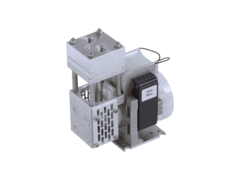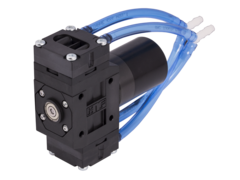Las bombas de diafragma para gases de KNF transfieren o comprimen gases y vapores y generan vacío sin con...
The Road to Cleaner Air: KNF Pumps in Particle Emission Management
Increasing environmental challenges and stricter emissions regulations require automotive manufacturers to find innovative approaches for reducing the environmental impact of their vehicles.

Starting in 2025, European emissions regulations will cover not only exhaust particles, but also dust emissions. Given the increased weight of electric vehicles, this mode of transportation also falls within the scope of regulations that focus on reducing the emissions of tires, brakes and road wear. KNF diaphragm pumps can play a vital role in the measurement and control systems developed for this purpose.
Euro Standards – Striving for Cleaner Air
Air quality, especially in large cities and areas with busy roads, has suffered due to the widespread use of private motorized transportation. That is why Europe's first emission directive was introduced as early as 1970, titled "Measures to be taken against air pollution by gases from positive-ignition engines of motor vehicles". First introduced in 1992 with Euro Standard 1, several new regulations have since been built on this first directive by regularly optimizing emission limits and standards for measuring these emissions. Most new land vehicles sold in the European Union must now emit fewer pollutants to meet the respective standard and therefore be allowed on the road.
In September 2015, the Euro 6 emission standard came into force in the EU. Two years later, these regulations were adapted again as part of the Euro 6c and Euro 6d standards. This time, however, it is not the limits that have been further tightened, but the criteria that the exhaust measurements themselves must meet. The emission limits of Euro 6 are expected to be replaced by Euro 7 in July 2025 to further minimize exhaust gas emissions through a regulated combustion process and control interventions.
Emission Testing Continues to Evolve
In laboratory testing of internal combustion engines, various methods are used to measure emissions such as CO, CO2, HC, and NOx. Among these methods, infrared and electrochemical measurements are the most commonly used. Infrared measurements rely on the absorption properties of CO and CO2 gas molecules in the infrared wavelengths of the electromagnetic spectrum. The technique involves shining an infrared beam through the gas sample and measuring the intensity of the beam as it passes through the gas. By analyzing the changes in intensity, the concentration of specific gas molecules can be determined. Infrared measurements are non-destructive and can be used to analyze a wide range of gases.
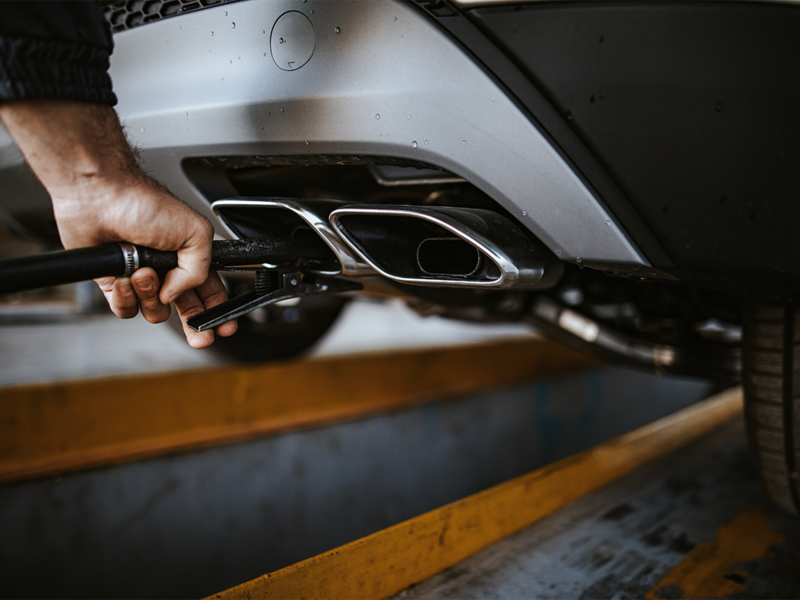
Electrochemical measurements, on the other hand, rely on electrochemical reactions to measure the concentration of gas types. For example, the fast and sensitive chemiluminescence method for measuring NOx is based on the chemical reaction of nitrogen oxides with ozone in a reaction chamber. The reaction emits light whose intensity is proportional to the concentration of NOx in the sample. Hydrocarbons on the other hand are measured with a flame ionization detector (FID). There, the sample is introduced into a flame, which burns the hydrocarbons and causes them to ionize. The resulting ions are then detected by an electric field, producing a current proportional to the concentration of hydrocarbons.
KNF Diaphragm Pumps in Emissions Testing
To collect the samples to be measured, these systems utilize gas pumps, such as a KNF NMP 830, to draw the gas sample from the engine exhaust. The pump operates at a constant flow rate, allowing for accurate and consistent gas sampling. In addition, a separate pump like a KNF NF 30 is used to remove any moisture that may be drawn from the exhaust and condensed in the intake tube. This is necessary to prevent any contamination or interference with the gas measurements.
For the above mentioned chemiluminescence measurements, gas pumps such as the N 920 or N 952 are typically used, while for FID measurements pumps such as the N 86.16 are preferred. Especially for the latter, these pumps are customized to effectively withstand high temperatures.
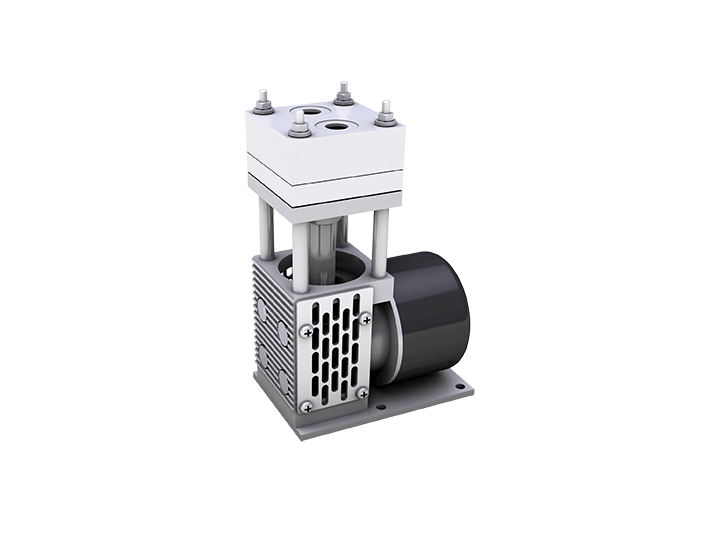
Like the measurement of gasoline engine emissions, diaphragm pumps are also required for the emission measurement of diesel engines to draw in the gas to be measured. In this case, for example, both KNF NMP 830.1.2 and NMP 850.1.2 are suitable, depending on the specific test requirements.
Real Driving Emissions: Taking Testing from the Bench to the Road
The Real Driving Emissions (RDE) test procedure introduced with the Euro 6d standard further tightened the test procedure. For the first time, the emissions must be determined under actual road conditions, thus while the vehicle is being driven on the road. For these measurements, a compact device is connected directly to the vehicle's exhaust. It ensures reliable on-road emission measurements of CO2, CO, NO and NO2 by measuring directly at the exhaust, even under changing test conditions such as varying ambient temperatures or pressures. For this mobile version, customized pumps, based for example on the compact NMP 850 diaphragm pump series, reliably and continuously transfer the exhaust gas to the measuring instruments.
Euro 7 Emissions Standard to Monitor Brake, Tire, and Road Wear Particles
Five years after the introduction of the last Euro standard, the next major step is expected in July 2025 with Euro 7. While previous emission standards have also set limits on the amount of particulate matter in the air, these limits are rarely met, especially in large cities. For the first time, the Euro 7 standard will focus on particulate emissions beyond exhaust gases, specifically from brakes, tires and road wear. This means that even electric cars will be affected by the new standard, as they generate higher levels of tire and road abrasion due to the added weight of the battery.
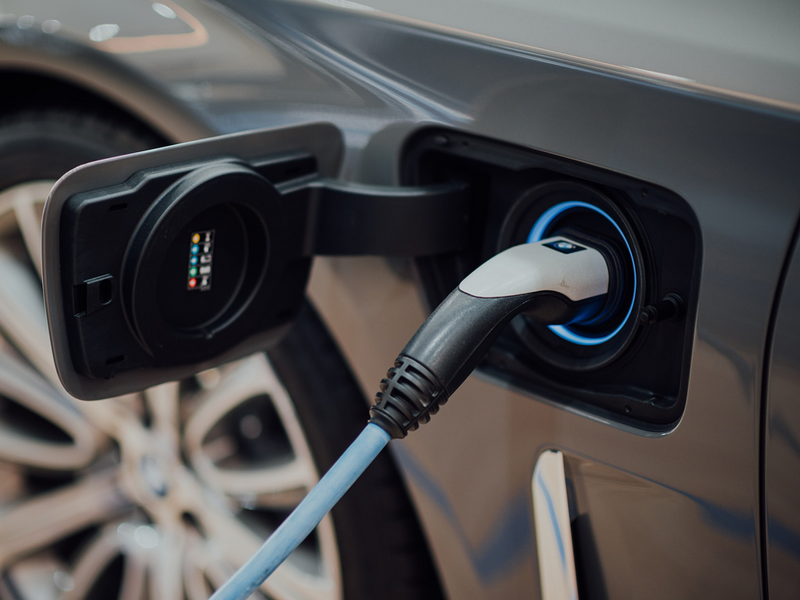
To measure emissions and prevent their release during everyday use of vehicles that comply with the new norm, special extraction systems are crucial. These systems collect brake and tire dust and analyze the quantity of emissions. To ensure the reliability of these measurements, it is essential to use suitable equipment, such as KNF diaphragm pumps like a customized N 916.0 as their clean and oil-free operation makes them particularly suitable for the reliable measurement of particle-rich emissions. The pump can then be designed to resist corrosion and equipped with a brushless motor for precise speed control.
Moreover, the modular design of KNF diaphragm pumps allows them to be easily adapted to the requirements of both stationary and mobile test systems. This is essential, as brake, tire, and asphalt particles contained in the aspirated air can cause significant abrasion and wear to measurement equipment. This flexibility allows the pumps to be optimized for resistance to abrasive particles, ensuring accurate and reliable measurements in the long term.

